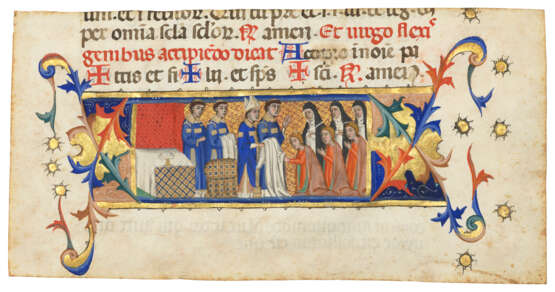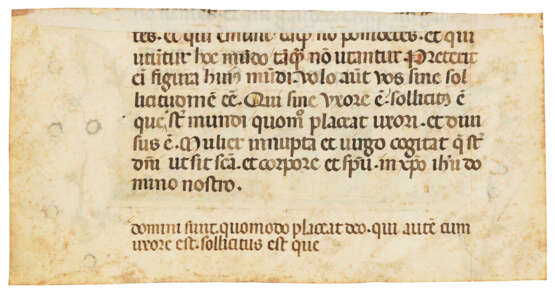ID 1249791
Lot 9 | The Puiggari Pontifical
Estimate value
£ 12 000 – 18 000
The Dominican reception of Novices, cut from a Pontifical, illuminated manuscript on vellum [Catalonia, Barcelona, c.1350-60]
A splendid miniature depicting a Dominican rite of passage, from a luxurious Catalan Pontifical.
c.123 x 243mm. A column-wide rectangular miniature depicting the reception of female novices against a diapered background, with acanthus leaves extending into the margin; four lines of text above: 'per omnia secula seculorum. Amen. Et virgo flexis genibus accipiendo dicat. Accipio in nomine patris et filii et spiritus sancti. Amen'; verso with nine lines of text, an excerpt from 1 Corinthians, 7:29-34, rubrics in red, initials in blue with red filigree decoration (a cutting, some slight foxing and a strip of paper hinge attached to the verso., else in good condition).
Provenance:
(1) The style of illumination (see below) indicates a Catalan production of the mid-14th century. Contemporary foliation on the surviving leaves from the parent manuscript indicate that the book would have had at least 230 leaves.
(2) 'M. Puiggari', late 18th/19th century: twenty leaves from the Pontifical were sold in Paris by Artcurial on 13 May 2014, lot 43 for €157,500, and subsequently appeared in Jörn Günther, Catalogue 11 (2015), Parchment and Gold, no 12. On f.33 of this substantial fragment appears a late 18th-century inscription: 'M. Puiggari ancien procureur du roy a Perpignan'. This may refer to either Pierre Puiggari (1768-1854), Benedictine monk, scholar, archaeologist, and author of the Catalogue biographique des évêques d’Elne (1842), or his nephew, Colonel Antoine Puiggari (1815-1890). Both were scholars of Catalan culture, and amassed a vast library in Perpignan.
A Pontifical contains the rites for liturgical celebrations conducted by a bishop, such as the consecration of lectors, deacons, monks, nuns, abbots and abbesses, as well as the consecration of churches, cemeteries and liturgical objects. Among the other surviving leaves and fragments we find text and illumination for the tonsuring of a cleric, the ordination of lectors, acolytes, subdeacons, and priests. The Dominican Reception of Novices was a rite of passage for entering the order and dedicating one’s life to God: in this miniature three Dominican nuns present three novices to a mitred bishop and three tonsured clerics. Consecrated tunics are presented to each novice, who are still clad in lay garments as they kneel before the prelate. The Rite of Clothing was followed after a period of probation by the actual profession.
Illumination:
The parent manuscript would have been a grand commission undoubtedly destined for use in an important cathedral. The style of illumination is firmly anchored within the royel ateliers of Barcelona c.1340-75, with strong influence from Italian and French art. There are strong similarities with two other contemporary manuscripts presumably originating in Barcelona: the Ordinacions fetes per lo senyor en Pere terz d’Arago (Paris, BnF, ms Espagnol 99; see F. Avril, Manuscrits enluminés de la péninsule ibérique, 1982, no 109) and the Cronica de S. Juan de la Peña (Salamanca, Univ. ms 2664). These were both illuminated by an artist working within the circle of the Master of San Marco, active in Barcelona in the middle of the 14th century. Our illuminator owes a lot to artists active in Avignon, where Italian influences will have been salient in the papal court, and his style can also be associated with one of the artists who painted the Pontifical de Pierre de la Jugie, archbishop of Narbonne (French Catalonia; Narbonne, Trésor de la Cathédrale Saint-Just, ms 02).
| Place of origin: | Europe, Spain |
|---|---|
| Auction house category: | Medieval & renaissance manuscripts, Books and manuscripts |
| Place of origin: | Europe, Spain |
|---|---|
| Auction house category: | Medieval & renaissance manuscripts, Books and manuscripts |
| Address of auction |
CHRISTIE'S 8 King Street, St. James's SW1Y 6QT London United Kingdom | |
|---|---|---|
| Preview |
| |
| Phone | +44 (0)20 7839 9060 | |
| Buyer Premium | see on Website | |
| Conditions of purchase | Conditions of purchase |




